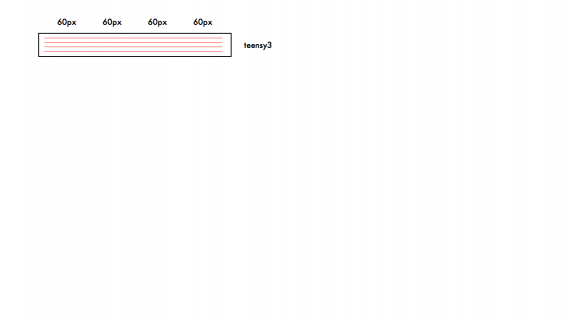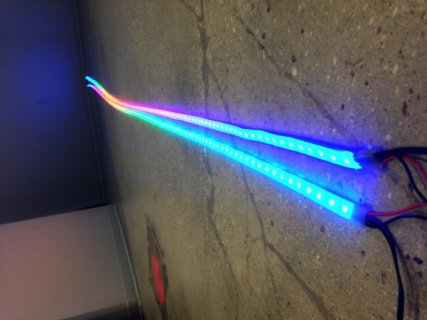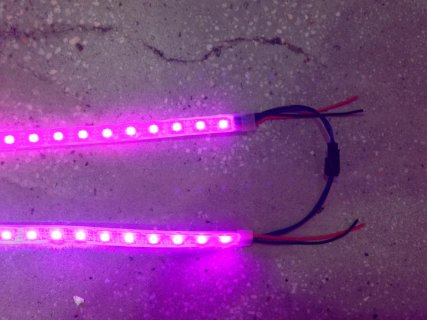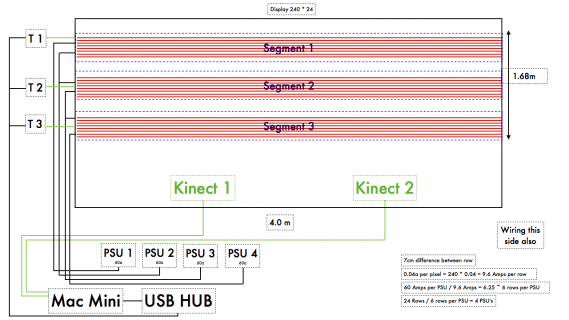Hi all,
I'm starting out on a diffused video wall to cover a large space approx 4 meters (wide) * 2.8 metres (tall).
I'm ok with programming ardunio / processing so going back to electronics is a little bit of a challenge for me. I really appreciate the many smart minds on this forum!
So. Going by OctoWS2811 LED Library page - I've divided up the wall into 8 segments of 60 * 16 - 960 pixels per segment
I not sure which orientation I should use - either lay the strips horizontally or vertically. But right now I'm leaning towards horizontally as then I can keep the strips together - as they come as one 4m length.
If I do it this way then i'll space the strips approx apart 9cm to get the 2.8 mete coverage I need. I'm hoping the scrim fabric I use to diffuse the colours should cover any dark spots. Hope that makes sense. I'm not running video across the display but using it for ambient animations so perfect density of the strips is not necessary.
Kit list
8 * Teensy 3 - 1 per segement
8 * 5V @ 60A PSU - 1 per segment
Adafruit NeoPixel Digital RGB LED Weatherproof Strip 60 LED - 1m - I'm buying from Adafruit as they can deliver very fast and quality control should be good.
1 - USB
Questions
If I run the strips as 4m lengths - Do I need to power the strips either end? Will that be ok?
Is running 1 teensy per segment (960 pixels) under using them? Can they run more? If so - roughly how much?
Is running 1 PSU per segment (960 pixels) under using them? Can they run more? If so - roughly how much?
I believe the PSU's are 60 amp and are 3 * 20 amp - So would they power 5-6 strips each? Do you wire them in series? What guage do I use? Bit worried about *this* to be honest!
How can I control the brightness of the LEDs other than keeping the colours in less bright rangers?
Can anyone recommend an 8 port USB hub that would power all 8 of the teensys?
Will the frame sync work with 8 segments?
Thanks all.
Really appreciate the community here.
Edit - I've added a schematic.
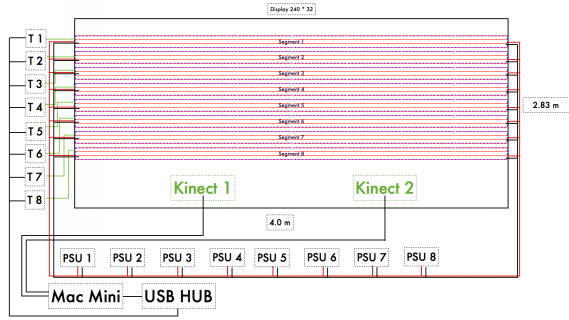
I'm starting out on a diffused video wall to cover a large space approx 4 meters (wide) * 2.8 metres (tall).
I'm ok with programming ardunio / processing so going back to electronics is a little bit of a challenge for me. I really appreciate the many smart minds on this forum!
So. Going by OctoWS2811 LED Library page - I've divided up the wall into 8 segments of 60 * 16 - 960 pixels per segment
I not sure which orientation I should use - either lay the strips horizontally or vertically. But right now I'm leaning towards horizontally as then I can keep the strips together - as they come as one 4m length.
If I do it this way then i'll space the strips approx apart 9cm to get the 2.8 mete coverage I need. I'm hoping the scrim fabric I use to diffuse the colours should cover any dark spots. Hope that makes sense. I'm not running video across the display but using it for ambient animations so perfect density of the strips is not necessary.
Kit list
8 * Teensy 3 - 1 per segement
8 * 5V @ 60A PSU - 1 per segment
Adafruit NeoPixel Digital RGB LED Weatherproof Strip 60 LED - 1m - I'm buying from Adafruit as they can deliver very fast and quality control should be good.
1 - USB
Questions
If I run the strips as 4m lengths - Do I need to power the strips either end? Will that be ok?
Is running 1 teensy per segment (960 pixels) under using them? Can they run more? If so - roughly how much?
Is running 1 PSU per segment (960 pixels) under using them? Can they run more? If so - roughly how much?
I believe the PSU's are 60 amp and are 3 * 20 amp - So would they power 5-6 strips each? Do you wire them in series? What guage do I use? Bit worried about *this* to be honest!
How can I control the brightness of the LEDs other than keeping the colours in less bright rangers?
Can anyone recommend an 8 port USB hub that would power all 8 of the teensys?
Will the frame sync work with 8 segments?
Thanks all.
Really appreciate the community here.
Edit - I've added a schematic.

Last edited:


